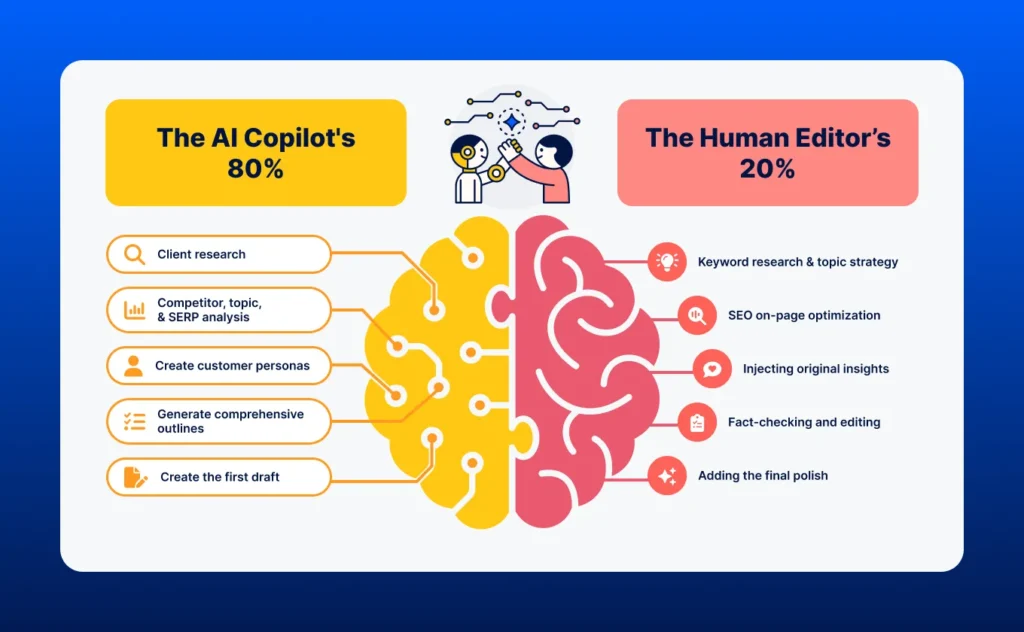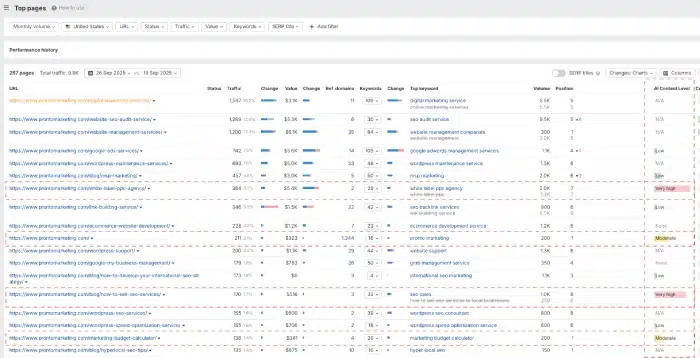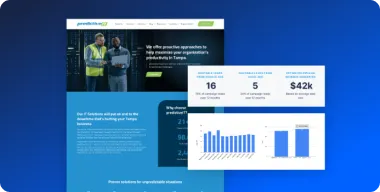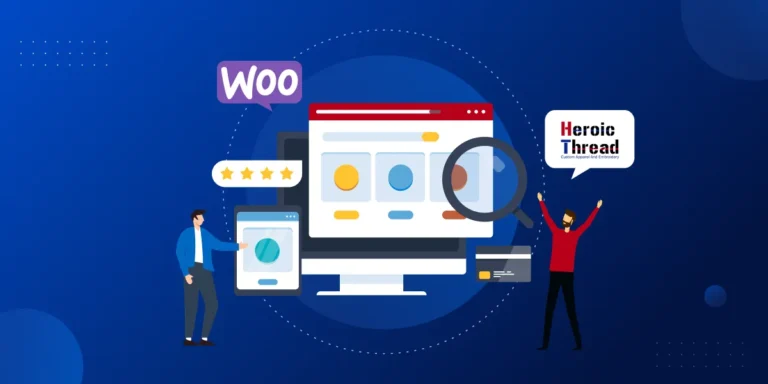When it comes to content creation, the phrase “AI-generated” often conjures images of generic, low-quality articles flooding the internet. It’s a common perception, and frankly, a valid one given the current landscape. Yet, what if we told you that AI (artificial intelligence), when used strategically, can be a powerful force for good, elevating content quality and driving real results?
According to a report by Ahrefs, 87% of marketers are using AI to create content.
The problem isn’t using AI, it’s using AI on “autopilot”.
At Pronto, we’ve embraced a different philosophy. AI as a strategic copilot, with a human expert always in the pilot’s seat.
This article pulls back the curtain on the exact, multi-phase workflow we use to create high-performing, AI-augmented content that builds authority, talks directly to your prospects and customers, and drives real business results.
Key takeaways
- The “Autopilot” Problem: Relying on single-prompt, unedited AI content leads to generic, inaccurate, and strategically blind articles that harm your brand and SEO.
- The “Copilot” Solution: A structured, multi-phase workflow uses AI for research, outlining, and first drafts, but always keeps a human expert in control of fact and quality checking, and adding final polish.
- Our 80/20 Approach: At Pronto, AI handles roughly 80% of the foundational work, empowering our human experts to focus on the critical 20%—fact-checking, injecting brand voice, and final polish.
- The End Result: This hybrid model allows for content creation at scale without sacrificing the quality, experience, and trust that both audiences and search engines want.
The “Autopilot” Problem: Why Single-Prompt Content Fails
Before we dive into our solution, it’s critical to understand what we avoid and why. The “autopilot” approach, feeding a single prompt into an AI tool and publishing the raw output, is a recipe for failure. It’s a shortcut that leads to a dead end, damaging your brand’s credibility and search rankings.
It’s Generic & Lacks Contextual Understanding
Autopilot content reads like a summary of a summary. It lacks a unique point of view, fails to capture a distinct brand voice, and cannot replicate the nuance of human experience. It tells the reader what is already known but offers no new insight, personality, or reason to care. This content doesn’t build a connection; it just fills a page.
It’s Factually Unreliable
AI tools, built on natural language processing, are designed to generate text, not to verify facts. This leads to a well-documented phenomenon known as “hallucinations,” where the AI confidently presents fabricated information as truth. For a business, this is a credibility killer.
Publishing unverified AI content is like letting an intern write a press release without review. The risk of reputational damage is simply too high.
It Lacks Strategic Insight
A single prompt cannot understand your specific business goals, the intricate pain points of your target audience (like Sarah, the Strategic B2B Marketer), or the competitive landscape you operate in. AI on autopilot can’t build a strategic narrative that guides a prospect through their buyer’s journey because it has no context for that journey. It creates content in a vacuum.
It’s an SEO Dead End
Google’s algorithms, including its Helpful Content System, are designed to reward content that demonstrates high levels of Experience, Expertise, Authoritativeness, and Trust (E-E-A-T). Low-effort, generic AI content is the exact opposite of this.
At Pronto, we focus on building “deep comprehensiveness” and “topical authority” for our clients. Autopilot content fails because it doesn’t build the deep, interconnected content library needed to master a topic. If you want to rank, you need a strategic library of expert content, not a collection of one-off, shallow articles. We wrote a complete guide on how to appear in AI search results that explains this strategy in detail.
Isn’t AI Content Bad for Google?
A common concern, and a valid one given the amount of low-quality AI content, is that Google penalizes AI-generated material. However, Google’s stance is more nuanced than a blanket ban. They don’t inherently dislike AI content; they dislike bad content, regardless of how it’s produced.
Google’s Gary Illyes clarified, “human created” isn’t precisely the right way to describe their AI content policy, and a more accurate description would be “human curated”.
Google’s official guidance, as stated by Danny Sullivan and Chris Nelson of the Google Search Quality team, focuses on rewarding “original, high-quality content that demonstrates qualities of what we call E-E-A-T: expertise, experience, authoritativeness, and trustworthiness”. They explicitly state, “Our focus on the quality of content, rather than how content is produced, is a useful guide that has helped us deliver reliable, high quality results to users for years.”
So, the key isn’t whether AI is used, but how it’s used. If AI assists in creating content that is factual, original, helpful, and provides genuine value to the user, and is subject to rigorous human oversight, it aligns with Google’s guidelines. This reinforces our “copilot” philosophy: AI as an accelerant for quality, not a shortcut for spam.
Why an AI Score Doesn’t Define Quality
In the wake of increased AI content, various AI detection tools have emerged, claiming to identify whether content was produced by LLMs.
But a high AI score from a detector doesn’t automatically mean the content is bad. The true measure of content quality should be determined by the reader, based on factors like accuracy, helpfulness, originality, and overall engagement, not by an algorithm designed to identify patterns associated with AI generationThe reliability of these AI detectors has also been called into question, even by Google, arguing that AI detectors are “unreliable” and “error-prone”.
This screenshot shows that the top-performing pages feature a mix of detected AI content levels, from “Low” to “Very high”. For example, the page ranking at position 1 has a “Moderate” AI level, while other highly-ranked pages are flagged as “Low” (position 2) and even “Very high” (position 4). This variety shows that search engine success is not tied to a specific AI content score but rather to the overall quality and relevance of the content.
Prerequisites for Using AI
Before diving into the multi-phase AI content creation workflow, it’s important to understand some foundational elements that ensure effective and responsible AI integration. These prerequisites are key to successfully integrating AI into your content creation process.
Format Your Prompts
To make sure your prompt is clear and effective with AI models, it’s best to use a structure it will understand. Below are the prompt structure elements we typically use.
- [CONTEXT]: Set the scene and explain the “why” behind the task. This provides the AI with the bigger picture, leading to more relevant and insightful responses.
- [PERSONA]: Instruct the AI on who it should be. This is crucial for controlling the tone, style, and expertise of the response.
- [TASK] or [TASKS]: Provide clear and actionable instructions on what you want the AI to do. If there are multiple steps, list them logically.
- [INPUT DATA]: Supply all the necessary information, data, or variables the AI needs to complete the task. If one of the input data is a document, attach the document and write “Attached Document” here.
- [RULES & CONSTRAINTS]: Define the boundaries and how the AI should perform the task, including what to avoid.
- [OUTPUT FORMAT]: Explicitly define the structure of the final response to ensure predictable and usable output.
- [EXAMPLE] (Optional but highly recommended): Provide a concrete example of the desired output to remove ambiguity and improve quality.
Keep reading to see an example 👇
Choose the Right AI Model
When leveraging AI as a copilot, selecting the appropriate model for your task is crucial for efficiency and quality. Different models are optimized for varying complexities and demands. We primarily use Google Gemini, but ChatGPT and Claude will have similar models best for different levels of complexity.
- Gemini 2.5 Flash: Ideal for simpler, high-volume tasks where speed and cost-effectiveness are paramount. This model excels at generating quick drafts, basic research summaries, or straightforward content pieces that require less nuanced understanding.
- Gemini 2.5 Pro: Best suited for more complex tasks that demand deeper reasoning, comprehensive analysis, and higher-quality output. Use this model for intricate research, strategic outlining, and the generation of polished, authoritative content where accuracy and sophistication are critical.
How We Use AI for Our Blog Content Service
Our “copilot” model transforms AI from a risky replacement into a powerful partner. It’s a structured, human-guided process that leverages AI for research, speed, and scale while ensuring human expertise provides the quality and strategy. This writing process is designed to produce the best possible outcome by assigning tasks to either the AI or the human expert based on their strengths.
It’s important to note that these prompts are not used in isolation. They are always referencing the information from the prompt output before it. For example, the research output will be fed into the following prompt to help create the content strategy. This ensures that the AI devotes its thinking to one task at a time, producing better quality results.
We have several workflows depending on the type of page/content we’re producing and here’s the multi-phase workflow we use to create blog content:
Step 1: Human-Led Topic Selection & Strategy
Before any AI models are engaged, the crucial first step is a human-led process of topic selection and strategic alignment. This foundational phase ensures that all content creation efforts are grounded in real audience needs, business objectives, and demand for the topic.
This involves:
- Keyword Research: Identifying high-value keywords with relevant search volume and manageable competition to ensure content has the potential to rank.
- Audience Insights: Researching common customer questions, pain points, and interests to ensure the chosen topic genuinely resonates with the target audience.
- Competitive Analysis: Reviewing existing content from competitors to identify gaps, opportunities for differentiation, and areas where our expertise can provide unique value.
- Business Goal Alignment: Ensuring the chosen topic supports broader marketing and business objectives, such as lead generation, brand awareness, or thought leadership.
- Content Calendar Planning: Strategically placing the topic within the overall content calendar to maintain a consistent publishing schedule and build topical authority over time.
This approach guarantees that the content journey begins with a clear purpose and a strong strategic foundation, setting the stage for AI to augment, rather than dictate, the creative process.
Step 2: AI-Powered Deep Research
We don’t start by asking AI, “Write a blog article about X.” Instead, we start by using it as a research assistant. We task it with analyzing SERPs (search engine results), identifying key sub-topics, understanding search intent, analyzing competitor content and offerings, identifying common audience questions from forums like Reddit and Quora, and understanding our client’s existing product and services, USP, and brand voice.
This phase includes both in-depth client-specific research and broader industry analysis to ensure comprehensive foundational knowledge. This isn’t about generating text; it’s about gathering intelligence to build winning content.
In the below prompt, pay attention to the [INPUT DATA] section. This is where we put the company’s name and website details, and the target keyword or topic we want to research.
Research Example:
AI: Google Gemini
Mode: 2.5 Pro (or equivalent Pro model)
[CONTEXT]
We are in the research phase for creating an informational blog article. The purpose of this research is twofold: 1) To gather specific information from our client’s website that subtly demonstrates their expertise on the target topic. 2) To conduct broader research on the topic to ensure the article is comprehensive, answers common user questions, and is supported by credible data.
[PERSONA]
You are a highly skilled Content Research Specialist. Your expertise is in synthesizing client-specific information and general topic data into a unified research brief. You are meticulous about citing sources for all factual claims, statistics, and client-specific insights.
[GOAL]
To produce a single, well-structured research document that provides all the necessary information for a writer to draft an authoritative blog post on the “Target Blog Topic/Keyword,” integrating the client’s expertise naturally.
[INPUT DATA]
– Client Name:
– Client Website:
– Target Blog Topic/Keyword:
[TASKS]
**Client Expertise Analysis:** Browse the provided `Client Website`. Your goal is to understand their core offerings, unique value proposition, and stated expertise as it relates to the `Target Blog Topic/Keyword`.
**Topic & Search Intent Analysis:** Research the `Target Blog Topic/Keyword`. Determine the primary search intent (e.g., informational, transactional), identify the most common questions users are asking, and list the core sub-topics that a comprehensive article must cover.
**Supporting Evidence Gathering:** Find credible, third-party statistics, data points, or expert quotes that are relevant to the `Target Blog Topic/Keyword` and can be used to add authority to the article.
[RULES & CONSTRAINTS]
– **Critical Rule:** You MUST provide a direct URL citation in brackets `()` immediately following any piece of information you gather. This applies to client-specific details, statistics, data, and quotes.
– Do not directly market or “sell” the client’s services. The goal is to identify their expertise and unique perspectives to be woven into the content.
– Provide up to 3 compelling statistics or expert quotes in the “Supporting Evidence” section. If the
[OUTPUT FORMAT]
– Use Markdown for formatting.
– Use H2 (##) headings for the main sections: “Client Expertise Analysis,” “Topic & Search Intent Analysis,” and “Supporting Evidence.”
– Use bullet points for lists.
[EXAMPLE]
## Client Expertise Analysis
– Fintech Innovate specializes in AI-driven chargeback reduction for e-commerce businesses. Their unique methodology focuses on predictive analytics to flag fraudulent transactions before they occur (https://www.fintechinnovate.com/our-methodology).
– They offer a solution called “Chargeback Shield” which integrates directly with Shopify and Magento platforms (https://www.fintechinnovate.com/solutions/chargeback-shield).
## Topic & Search Intent Analysis
– **Primary Search Intent:** Informational. Users are looking for strategies and tactics to reduce e-commerce chargebacks.
– **Core Questions & Sub-topics:**
– What is a chargeback?
– Why are chargebacks bad for business?
– How to prevent fraudulent chargebacks.
– Best practices for disputing chargeback claims.
## Supporting Evidence
– E-commerce merchants could lose as much as $125 billion to online fraud in 2024 (https://www.juniperresearch.com/press/e-commerce-fraud-losses-to-exceed-125-billion).
– Approximately 86% of all chargebacks are probable cases of “friendly fraud” (https://chargebacks911.com/friendly-fraud/).
– “The best defense against chargebacks is a good offense. Clear communication and transparent policies are your first line of defense.” – Jane Doe, Retail Analyst (https://www.ecommercetimes.com/story/expert-advice-on-chargebacks).
Step 3: AI-Assisted Content Strategy
Armed with deep strategic research, we use AI to structure comprehensive outlines. The goal is to create a logical flow that will most thoroughly and clearly answer the user’s entire question and any potential follow-up questions.
Content Strategy Development
AI: Google Gemini
Mode: 2.5 Pro (or equivalent Pro model)
[CONTEXT]
We have completed the initial research phase for a blog article. The next step is to transform this raw research into a strategic content plan. This plan will serve as the definitive blueprint for the writer, ensuring the final article is engaging, authoritative, and aligns with the client’s goals.[PERSONA]
You are a highly skilled Blog Content Strategist and Information Architect. Your expertise is in analyzing research to define audience needs, structure compelling narratives, and devise strategies for subtly integrating a client’s expertise into informational content. You are meticulous about source credibility.[GOAL]
To generate a comprehensive content strategy document based on the provided research. This document will guide the creation of an authoritative and engaging blog post on the “Target Blog Topic/Keyword.”[INPUT DATA]
– Client Name:
– Client Website:
– Target Blog Topic/Keyword:
– Research Document: ATTACHED
– Additional Comments:[TASKS]
1. **Develop Audience Persona:** Based on the research, create one informational persona for the blog’s target reader. Focus on their goals, challenges, and content preferences.
2. **Define Core Questions:** Distill the research into the top 5-7 essential questions the blog post must answer to be comprehensive for the target audience.
3. **Strategize Client Integration:** Propose 1-2 specific, non-salesy methods to weave the client’s unique expertise or offerings (identified in the research) into the article’s narrative.
4. **Enforce Sourcing Rules:** Review the sources from the research. Propose strategic placement for sources that meet the credibility criteria and explicitly state a policy for handling unsourced but valuable information.
5. **Propose Informational CTAs:** Suggest 1-3 non-aggressive, value-oriented calls-to-action relevant to the client’s offerings mentioned in the research.
6. **Incorporate User Comments:** Analyze the `Additional Comments` and integrate any specific directives as a top priority in the strategy plan.[RULES & CONSTRAINTS]
– **Critical Citation Rule:** When proposing an external link or citation, the source MUST be either a famous, authoritative entity (e.g., Forbes, a .gov site) OR be cited for a specific, verifiable statistic (not a promotional claim). If a source from the research doesn’t meet these criteria, you may use its information for background knowledge but MUST NOT propose linking to it.
– **Client Integration:** All suggestions for integrating the client must be subtle and aimed at demonstrating expertise, not direct selling.
– **User Comments:** Any instructions derived from the `Additional Comments` must be explicitly noted as a priority.
– **Output Format:** The final output must be a single, well-structured Markdown document.[OUTPUT FORMAT]
– Use H2 (##) headings for each major section (e.g., “Audience Persona,” “Core Questions to Answer”).
– Use bullet points for lists.
– For every proposed source citation, you MUST include the direct URL.[EXAMPLE]
## Audience Persona
– **Persona Name:** “The Proactive Planner”
– **Primary Information Goals:** To understand the fundamental principles of financial planning for retirement.
– **Key Informational Challenges:** Overwhelmed by jargon; unsure where to start.## Core Questions to Answer
– What is a 401(k) and how does it differ from an IRA?
– How much money do I actually need to retire?
– What are the best investment strategies for beginners?## Client Integration Strategy
– In the section discussing different investment strategies, we can introduce the client’s philosophy on “values-based investing” as a specific approach, linking to their “Our Philosophy” page (https://client.com/philosophy).## Credibility & Sourcing Plan
– **Approved Source:** The statistic on average retirement savings should be cited from the Federal Reserve survey (https://federalreserve.gov/survey.pdf).
– **Policy Note:** The research mentions a “trend” of younger investors prioritizing ESG funds, but the source is a small blog. We should frame this as an “observed industry trend” without a direct citation.## Informational CTA Ideas
– “Download our free ‘Retirement Planning Checklist’ to get started on your journey.”
– “Read our case study on how we helped a client achieve their retirement goals.”## Priority Directives from Comments
– **Priority:** The client has stressed that the tone should be encouraging and accessible, avoiding overly complex financial terminology. This must be the guiding principle for the writer.
Step 4: Outline Development
With the content strategy complete, the next step is to translate it into a structured outline. This will guide the content creation, ensuring a logical flow and comprehensive coverage of the topic.
Outline Development
AI: Google Gemini
Mode: 2.5 Pro (or equivalent Pro model)
[CONTEXT]
We have completed the research and strategy phases. This is the final step before writing the full draft. The goal is to take the approved content strategy and a specific writing guide to build a detailed, section-by-section blueprint for blog post. This outline will ensure the final copy is engaging, logical, persuasive, and aligned with the project’s objectives.[PERSONA]
You are an expert Marketing Strategist and Copywriter. You excel at translating research and strategy into compelling content structures that guide a user through a journey, from their initial awareness level to a final call-to-action.[GOAL]
To create a comprehensive and strategically structured outline for the specified landing page. This outline will serve as the definitive blueprint for the copywriter.[INPUT DATA]
– Client Name:
– Target Search Term:
– Content Strategy Document: ATTACHED
– Additional Comments:[TASKS]
1. **Synthesize All Inputs:** Thoroughly review and integrate all information from the `Content Strategy Document`, the `Page Type Writing Guide`, and any `Additional Comments`.
2. **Determine Audience Awareness:** Based on the research and `Target Search Term`, explicitly state the primary awareness level of the target audience (e.g., Unaware, Problem Aware, Solution Aware, Product Aware).
3. **Structure the Outline:** Following the structure provided in the `Page Type Writing Guide`, build the landing page outline section by section.
4. **Detail Each Section:** For every section and sub-section in the outline, provide a concise “Purpose Statement” and 3-5 “Key Messages/Content Points” as bullet points, incorporating relevant facts, data, and pain points from the `Content Strategy Document`.[RULES & CONSTRAINTS]
– **Critical Rule:** The outline’s structure MUST follow the blueprint laid out in the `Page Type Writing Guide`.
– The flow of the outline, from the hero section to the final CTA, must logically align with the determined Audience Awareness level.
– All key information, pain points, data, and client-specific details from the `Content Strategy Document` must be integrated into the “Key Messages” of the relevant sections.[OUTPUT FORMAT]
– The final output must be a single, complete outline in Markdown.
– Use H2 (##) for main section titles (e.g., “Hero Section,” “Problem & Agitation”).
– Use H3 (###) for the “Purpose” and “Key Messages” labels within each section.[EXAMPLE]
## Section 2: The Problem & Agitation### Purpose
To make the visitor feel understood by clearly articulating the primary pain points they are experiencing, demonstrating that we know their world.### Key Messages
– Start by stating the core problem: “Managing invoices manually is time-consuming and prone to costly errors.”
– Agitate the problem with a specific, relatable consequence: “A single misplaced decimal point or a missed deadline can damage vendor relationships and impact cash flow.”
– Use a powerful statistic from our research: “Businesses that rely on manual AP processing spend an average of $15 per invoice, compared to just $2 for automated systems.”
– Introduce the emotional cost: “This isn’t just about money; it’s about the stress and frustration of being buried in paperwork instead of growing your business.”
Step 5: AI-Generated Content Creation
With the strategic outline in place, the AI will generate the initial draft of the content. During this phase, the AI is prompted to create content that is not only informative but also inherently optimized for relevant keywords and search intent, laying the groundwork for strong SEO performance.
Content Development
AI: Google Gemini
Mode: 2.5 Pro (or equivalent Pro model)
[CONTEXT]
This is the final stage of content creation. All research, strategy, and outlining are complete. This task is to synthesize all provided materials into a final, well-written, and authoritative blog article ready for publication. The article must strictly adhere to the provided blueprint and guides.[PERSONA]
You are an Expert Content Writer and Information Architect. You specialize in transforming strategic outlines into high-quality, engaging, and authoritative blog articles that educate readers and establish a client’s expertise.[GOAL]
To write the complete, final draft of the blog article based on the provided outline, strategy, and writing guides, formatted perfectly in Markdown.[INPUT DATA]
– Approved Outline: ATTACHED
– Content Strategy Document: ATTACHED
– Primary Keyword:
– Secondary Keywords:[TASKS]
1. **Write the Full Article:** Use the `Approved Outline` as the definitive structure. Write compelling copy for every section and sub-section, ensuring a logical narrative flow.
2. **Integrate Strategy & Research:** Weave in all relevant details from the `Content Strategy Document`. Address the target persona’s needs, incorporate client solutions, and use the specified tone.
3. **Incorporate Keywords:** Naturally integrate the `Primary Keywords` and `Secondary Keywords` throughout the content, prioritizing readability over keyword density.
4. **Create Metadata:** At the very top of the output, generate a Markdown table containing the Target Keyword, a proposed page slug, a Title Tag (max 59 chars), and a Meta Description (max 155 chars).[RULES & CONSTRAINTS]
– **Word Count:** Unless otherwize stated, the length should be around 1,500 – 2,000 words.
– **Critical Hyperlinking Rule:** When citing information from an external source mentioned in the strategy, the anchor text MUST be hyperlinked to the corresponding citation URL. Example: **[According to HubSpot](https://blog.hubspot.com/marketing/stats)**, 80% of marketers…
– **Citation Integrity:** All statistics and direct quotes included in the article MUST have a corresponding citation URL from the research. If a URL is not available for a stat, do not include that stat.
– **Placeholder Rule:** If any placeholders for data (e.g., “[Insert Client Testimonial Here]”) are used, they must be clearly marked within the text.
– **Structure Adherence:** You MUST follow the structure provided in the `Approved Outline` precisely. Do not add, remove, or reorder sections.
– **Style Adherence:** The tone and style of the writing must conform to the `Page Writing Guide`.[OUTPUT FORMAT]
– The entire output must be a single Markdown document.
– Start with the two-column metadata table.
– Use correct Markdown for all headings (# for H1, ## for H2, ### for H3), bolding (**text**), lists (* or 1.), and links ([Link Text](URL)).
– Ensure there is a space after the # symbols in headings.[EXAMPLE OF METADATA TABLE]
| Attribute | Content |
| :— | :— |
| Target keyword | {{27.rowValues[].`3`}} |
| Page slug | /your-proposed-slug-here |
| Title Tag (Max 59) | A Compelling Title Tag Under 59 Characters |
| Meta Description (Max 155) | An engaging meta description that entices clicks and stays under the 155-character limit. |# The Main Title of the Blog Article (H1)
## Section 1 Title From Outline (H2)
This is the opening paragraph for the first section, written in an engaging and authoritative tone…
Step 6: Human-Led Review, Fact-Check, Polish & QC
This is where the human expert takes over completely. Our editors verify every statistic, claim, and source, ensuring factual accuracy and building trust. They replace any generic AI copy with a brand voice, original insights, and authentic anecdotes. Finally, our editors review the content for strategic alignment, clarity, flow, and overall impact, anchor text, and external linking, ensuring the piece is not just informative but persuasive.
Our 80/20 Approach
This multi-phase, human-directed system is so effective that AI assists with roughly 80% of the foundational work. The research, data synthesis, and first-draft creation. This empowers our human editors to focus their time on fact-checking, polishing, and inserting original ideas.
Here’s how that division looks in practice:

The Irreplaceable 20%: Why the Human Editor is the MVP
That final 20% is a purely human part of the process, and it is our non-negotiable final step. This is where our editors perform the critical tasks that AI simply can’t always be trusted to do.
Fact-Checking & Validation for Trust
This goes beyond just catching AI hallucinations. Our editors verify every statistic, claim, and source. They ensure every piece of information is accurate, up-to-date, and attributed correctly. This process is how we build the Trust that is the final, and perhaps most important, pillar of Google’s E-E-A-T guidelines.
Injecting Experience
This is where we address the ‘E’ for Experience. An AI has never run a marketing campaign, troubleshooted a network issue, or felt a customer’s frustration. This is where you can provide your expertise, anecdotes, and experience.
Strategic Alignment & Final Polish
Finally, an editor reviews the content to ensure it does more than just answer a question. Does it support a broader business goal? Does it speak directly to the target persona? Does it guide the reader toward a logical next step? They polish every sentence for clarity, flow, and impact, ensuring the final piece is not just informative but also persuasive.
Conclusion
The “copilot” model isn’t about replacing humans; it’s about augmenting them. Our 80/20 approach allows for unprecedented speed and scale without sacrificing the quality, strategy, and creativity that define great content.
The future of content marketing isn’t AI vs. Human; it’s a powerful synthesis of both. Success comes from a deep, strategy-first process where a human expert is always in the driver’s seat, using AI as a tool to execute a vision. Adopting this “copilot” mindset is how smart businesses will win in the new era of content marketing.
Did you enjoy this read? 80% of it was created by this very AI workflow, and the rest was fact checked, edited, polished, and additional insights added by yours truly, Chris Thomson, Client Marketing Manager at Pronto 🙂.
Ready to see how a smart AI copilot strategy can transform your content? At Pronto, we combine cutting-edge technology with irreplaceable human expertise to create content that drives results. Contact us today to learn more about our content marketing services.








